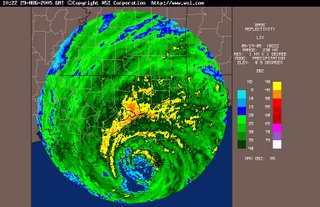Hurricane season blows in again ... get ready says NOAA
 At a news conference at the NOAA National Hurricane Center on Monday, Deputy Secretary of Commerce David A. Sampson Deputy Secretary of Commerce at the NOAA National Hurricane Center said, "For the 2006 north Atlantic hurricane season, NOAA is predicting 13 to 16 named storms, with eight to 10 becoming hurricanes, of which four to six could become 'major' hurricanes of Category 3 strength or higher" The impact from these storms extends well beyond coastal areas so it is vital that residents in hurricane prone areas get ready in advance of the hurricane season." (pic Katrina (C) NOAA)
At a news conference at the NOAA National Hurricane Center on Monday, Deputy Secretary of Commerce David A. Sampson Deputy Secretary of Commerce at the NOAA National Hurricane Center said, "For the 2006 north Atlantic hurricane season, NOAA is predicting 13 to 16 named storms, with eight to 10 becoming hurricanes, of which four to six could become 'major' hurricanes of Category 3 strength or higher" The impact from these storms extends well beyond coastal areas so it is vital that residents in hurricane prone areas get ready in advance of the hurricane season." (pic Katrina (C) NOAA)
Several key factors have led to the prediction ;
1. Warmer ocean water combined
2. Lower wind shear
3. Weaker easterly trade winds
4. More favorable wind pattern in the mid-levels of the atmosphere
All combining for the development of storms in greater numbers and to greater intensity. Warm water is the energy source for storms while favorable wind patterns limit the wind shear that can tear apart a storm's building cloud structure.
This confluence of conditions in the ocean and atmosphere appears to be strongly correlated to a climate pattern known as the multi-decadal signal, which has been in place since 1995. Since then, nine of the last 11 hurricane seasons have been above normal, with only two below-normal seasons during the El Niño years of 1997 and 2002.(Click here for a very useful NOAAA large scale graphic explaining how it works)
With neutral El Niño/Southern Oscillation (ENSO) (National Weather report )conditions expected across the equatorial Pacific during the next three to six months, the NOAA Climate Prediction Center scientists say that neither El Niño nor La Niña likely will be a factor in this year's hurricane season.
Market reactions to the news
Natural-gas futures climbed more than 5% Monday to their first gain in four sessions.Natural gas for June delivery climbed as high as $6.35 per million British thermal units Monday, its highest intraday level since May 17. The contract closed up 31.4 cents, or 5.3%, at $6.276.and crude prices recovered from a seven-week low.
The impacts of last season's hurricanes are still being felt in the Gulf. a full assesment of the physical damage is available from the MMS here.... stunning economic consequences.
Around 1.3 billion cubic feet of natural-gas production, or 13% of daily output, remains offline as of May 3 in the Gulf because of the two hurricanes last year, according to the U.S. Minerals Management Service (MMS). A total of 748.9 billion cubic feet, or 20.5%, of yearly production in the region was lost between Aug. 26 last year and May 3.
Around 324,445 barrels of oil per day also remains offline in the Gulf as of May 3. That's 21.6% of daily oil production in the area, according to the MMS. A total of 153.5 million barrels, or 28% of the yearly production in the Gulf has been shut in between Aug. 26 last year and May 3.
Crude for June delivery closed Monday at $69.23 a barrel, up 70 cents on the New York Mercantile Exchange.Today , Tuesday 23rd Crude for July delivery closed up $1.80 at $71.76 a barrel.
The OPEC OIl Cartel meets in Venezuela on June 1st and Venezuela's Energy Minister Rafael Ramirez said Monday that the fundamentals in the oil market call for a production cut.
If you want to read the true story of how the Louisiana National Guard did a fantastic job all tyhrough Katrina go here .... get the Truth.

No comments:
Post a Comment